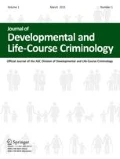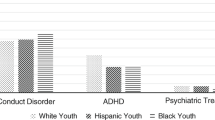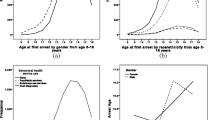Abstract
Purpose
The current study examines the prevalence and correlates of serious, violent, and chronic offending among female juveniles admitted to juvenile justice residential programs in the state of Florida.
Methods
Results are based on 3008 female youth who completed juvenile justice residential commitment programs from July 1, 2009 to June 30, 2014. Prevalence and correlates of serious, violent, and chronic offending among female youth were examined using logistic regression. Correlates include criminal history, individual, and mental health risk factors as well as temperament constructs.
Results
This sample of deep-end female offenders evidenced a serious, violent, and chronic prevalence rate of 27%. Female youth who offended earlier in life, those who were gang-involved, had a history of child welfare involvement, and had conduct disorder or temperament problems are more likely to evidence serious, violent, and chronic offending patterns.
Conclusions
Serious, violent, and chronic female offenders represent a unique subset of juvenile offenders, presenting with myriad of mental health, temperamental, and individual risk factors. Large studies, such as the current examination, are needed to adequately understand the risks and correlates of serious, violent, and chronic offending among female delinquent youth.
Similar content being viewed by others
Notes
One hundred and seventy-four females were excluded from the analysis due to placement lengths under 90 days. These would most often be youth transferred to other programs and unusual circumstances. While length of placement in Florida is indeterminate, and only a judge may approve release, all FDJJ residential programs have anticipated lengths of stay over 3 months (for descriptions of individual FDJJ facilities, see http://www.djj.state.fl.us/programs-facilities/residential-facilities). Additionally, 540 females were excluded due to not having been assessed using the R-PACT. The exclusions based on the lack of R-PACT assessment were due to the timing of the 2009–2010 statewide implementation of the R-PACT and the youth’s admission date (as the R-PACT was implemented during 2009–2010, only new admissions were required to be assessed).
As mentioned above, there are different possible constellations of serious and/or violent and/or chronic that make up the group of remaining youth. Of this group, 2% were violent only, 30.7% were classified as serious only, 8.4% were chronic only, 23.8% were serious and chronic but not violent, and finally 35.1% were classified as violent and serious but not chronic. Within this sample of youth in residential facilities, the majority of violent offenders had been adjudicated of a felony and were thus also classified as a serious offender. Only a misdemeanor weapons offense would qualify a youth as violent only (and not serious), which accounts for the small proportion of violent only offenders included in the present study. From this ancillary analysis, we can also see that there is a significant proportion of youth who have been classified as serious, but are neither violent nor chronic offenders.
Unfortunately, the R-PACT assessment does not contain information on divorce/parental separation. Therefore, the measure of ACEs included has a possible range of 0–9, which has been used in prior research utilizing data from the state of Florida.
We conducted exploratory factor analysis (EFA) as the temperament items were believed to possibly represent similar/identical constructs. Prior work examining temperament in FDJJ community-based samples has used indices of temperament constructs (cf. [58]). However, EFA indicated that the items were better retained individually for the current sample.
References
Blumstein, A., Cohen, J., Roth, J. A., & Visher, C. A. (Eds.). (1986). Criminal careers and ‘career criminals’. Washington DC: National Academy Press.
DeLisi, M., & Piquero, A. R. (2011). New frontiers in criminal careers research, 2000-2011: a state-of-the-art review. Journal of Criminal Justice, 39, 289–301.
Piquero, A. R., Farrington, D. P., & Blumstein, A. (2003). The criminal career paradigm: background and recent developments. In M. Tonry (Ed.), Crime and justice: a review of research (Vol. 30, pp. 359–506). Chicago: University of Chicago Press.
Tracy, P. E., Wolfgang, M. E., & Figlio, R. M. (1990). Delinquency careers in two birth cohorts. New York: Plenum Press.
Vaughn, M. G., DeLisi, M., Gunter, T., Fu, Q., Beaver, K. M., Perron, B. E., & Howard, M. O. (2011). The severe 5%: a latent class analysis of the externalizing spectrum in the United States. Journal of Criminal Justice, 39, 75–80.
Vaughn, M. G., DeLisi, M., Salas-Wright, C., & Maynard, B. R. (2014). Violence and externalizing behavior among youth in the United States is there a severe 5%? Youth Violence and Juvenile Justice, 12, 3–21.
Wolfgang, M. E., Figlio, R. M., & Sellin, T. (1972). Delinquency in a birth cohort. Chicago: University of Chicago Press.
DeLisi, M., Vaughn, M. G., Beaver, K. M., Wexler, J., Barth, A., & Fletcher, J. (2011). Fledgling psychopathy in the classroom: ADHD subtypes, psychopathy, and educational outcomes in a community sample of adolescents. Youth Violence and Juvenile Justice, 9, 43–58.
Loeber, R., & Farrington, D. P. (Eds.). (1998). Serious and violent juvenile offenders: risk factors and successful interventions. Thousand Oaks: Sage.
Moffitt, T. E. (1993). Adolescence-limited and life-course-persistent antisocial behavior: a developmental taxonomy. Psychological Review, 100, 674–701.
Moffitt, T. E. (2003). Life-course-persistent and adolescence-limited antisocial behavior: a 10-year research review and a research agenda. In B. B. Lahey, T. E. Moffitt, & A. Caspi (Eds.), Causes of conduct disorder and juvenile delinquency (pp. 49–75). New York: The Guilford Press.
Baglivio, M. T., Jackowski, K., Greenwald, M. A., & Howell, J. C. (2014). Serious, violent, and chronic juvenile offenders: a statewide analysis of prevalence and prediction of subsequent recidivism using risk and protective factors. Criminology & Public Policy, 13, 83–116.
DeLisi, M. (2005). Career criminals in society. Thousand Oaks: Sage.
Salekin, R. T., & Lynam, D. R. (Eds.). (2010). Handbook of child and adolescent psychopathy. New York: The Guilford Press.
Vaughn, M. G., & DeLisi, M. (2008). Were Wolfgang’s chronic offenders psychopaths? On the convergent validity between psychopathy and career criminality. Journal of Criminal Justice, 36, 33–42.
Cohen, M. A. (1998). The monetary value of saving a high-risk youth. Journal of Quantitative Criminology, 14, 5–33.
Cohen, M. A., & Piquero, A. R. (2009). New evidence on the monetary value of saving a high-risk youth. Journal of Quantitative Criminology, 25, 25–49.
DeLisi, M., & Gatling, J. M. (2003). Who pays for a life of crime? An empirical assessment of the assorted victimization costs posed by career criminals. Criminal Justice Studies, 16, 283–293.
DeLisi, M., Kosloski, A., Sween, M., Hachmeister, E., Moore, M., & Drury, A. (2010). Murder by numbers: monetary costs imposed by a sample of homicide offenders. The Journal of Forensic Psychiatry & Psychology, 21, 501–513.
Eme, R. (2010). Male life-course-persistent antisocial behavior: the most important pediatric mental health problem. Archives of Pediatrics and Adolescent Medicine, 164, 486–487.
Piquero, N. L., & Piquero, A. R. (2015). Life-course-persistent offending. In F. T. Cullen, P. Wilcox, J. L. Lux, & C. L. Jonson (Eds.), Sisters in crime revisited: bringing gender into criminology. New York: Oxford University Press, 67-82.
Glueck, S., & Glueck, E. T. (1930). 500 criminal careers. New York: Knopf.
Robins, L. N., & O’Neal, P. (1958). Mortality, mobility, and crime: problem children thirty years later. American Sociological Review, 23, 162–171.
Piquero, A. R., & Moffitt, T. E. (2005). Explaining the facts of crime: how the developmental taxonomy replies to Farrington’s invitation. In D. P. Farrington (Ed.), Integrated developmental & life-course theories of offending: advances in criminological theory (pp. 51–72). New Brunswick: Transaction.
Jennings, W. G., Rocque, M., Fox, B. H., Piquero, A. R., & Farrington, D. P. (2016). Can they recover? An assessment of adult adjustment problems among males in the abstainer, recovery, life-course persistent, and adolescence-limited pathways followed up to age 56 in the Cambridge Study in Delinquent Development. Development and Psychopathology, 28, 537–549.
Snyder, H. N. (1998). Serious, violent, and chronic juvenile offenders: an assessment of the extent of and trends in officially recognized serious criminal behavior in a delinquent population. In R. Loeber & D. P. Farrington (Eds.), Serious & violent juvenile offenders: risk factors and successful interventions (pp. 428–444). Thousand Oaks: Sage.
Piquero, A. R., Hawkins, J. D., & Kazemian, L. (2012). Criminal career patterns. In R. Loeber & D. P. Farrrington (Eds.), From juvenile delinquency to adult crime: criminal careers, justice policy, and prevention. New York: Oxford University Press, 14-46.
Henwood, K. S., Chou, S., & Browne, K. D. (2015). A systematic review and meta-analysis on the effectiveness of CBT informed anger management. Aggression and Violent Behavior, 25(Part B), 280–292.
Howell, J. C. (2009). Preventing and reducing juvenile delinquency: a comprehensive framework. Thousand Oaks: Sage.
Loeber, R., Farrington, D. P., & Waschbusch, D. A. (1998). Serious and violent juvenile offenders. In R. Loeber & D. P. Farrington (Eds.), Serious and violent juvenile offenders: risk factors and successful interventions. Thousand Oaks: Sage.
Kempf-Leonard, K., Tracy, P. E., & Howell, J. C. (2001). Serious, violent, and chronic juvenile offenders: the relationship of delinquency career types to adult criminality. Justice Quarterly, 18, 449–478.
DeLisi, M., & Vaughn, M. G. (2015). Correlates of crime. In A. R. Piquero (Ed.), Handbook of criminological theory, Wiley-Blackwell, 18-36.
Blackburn, A. G., & Trulson, C. R. (2010). Sugar and spice and everything nice? Exploring institutional misconduct among serious and violent female delinquents. Journal of Criminal Justice, 38, 1132–1140.
DeLisi, M. (2002). Not just a boy’s club: an empirical assessment of female career criminals. Women & Criminal Justice, 13, 27–45.
Thomson, N. D., Towl, G. J., & Centifanti, L. (2016). The habitual female offender inside: how psychopathic traits predict chronic prison violence. Law & Human Behavior. doi:10.1037/lhb0000178.
Odgers, C. L., Moretti, M., Burnette, M. L., Chauhan, P., Waite, D., & Reppucci, N. D. (2007). A latent variable modeling approach to identifying subtypes of serious and violent female juvenile offenders. Aggressive Behavior, 33(4), 339–352.
Zahn, M. A., Agnew, R., Fishbein, D., Miller, S., Winn, D., Dakoff, G., Kruttschnitt, C., Giordano, P., Gottfredson, D. C., Payne, A. A., Feld, B. C., & Chesney-Lind, M. (2010). Causes and correlates of girls’ delinquency. Washington: Office of Juvenile Justice and Delinquency Prevention.
Moffitt, T. E. (1994). Natural histories of delinquency. In H. J. Kerner & Weitekamp (Eds.), Cross-national longitudinal research on human development and criminal behavior (pp. 3–61). Dordrecht: Kluwer Academic Press.
Baird, C., Healy, T., Johnson, K., Bogie, A., Dankert, E. W., & Scharenbroch, C (2013). A comparison of risk assessment instruments in juvenile justice. Madison, WI: National Council on Crime and Delinquency .
Baglivio, M. T., Wolff, K. T., Jackowski, K., & Greenwald, M. A. (2015). A multilevel examination of risk/need change scores, community context, and successful reentry of committed juvenile offenders. Youth Violence and Juvenile Justice, 1–24. doi:10.1177/1541204015596052.
Fontaine, N., Carbonneau, R., Vitaro, F., Barker, E. D., & Tremblay, R. E. (2009). Research review: a critical review of studies on the developmental trajectories of antisocial behavior in females. Journal of Child Psychology and Psychiatry, 50, 363–385.
Hay, C. (2013). Residential Positive Achievement Change Tool (R-PACT) validation study. Sponsored by Florida State University and the State of Florida, Department of Juvenile Justice http://criminology.fsu.edu/wp-content/uploads/R-PACT-Validation-Study.pdf.
Fox, B. H., Perez, N., Cass, E., Baglivio, M. T., & Epps, N. (2015). Trauma changes everything: examining the relationship between adverse childhood experiences and serious, violent and chronic juvenile offenders. Child Abuse & Neglect. doi:10.1016/j.chiabu.2015.01.011.
Garrido, V., & Morales, L. A. (2007). Serious (violent or chronic) juvenile offenders: a systematic review of treatment effectiveness in secure corrections. In The Campbell Collaboration Reviews of Intervention and Policy Evaluations (C2-RIPE). Philadelphia: Campbell Collaboration.
Thornberry, T. P., Huizinga, D., & Loeber, R. (1995). The prevention of serious delinquency and violence: implications from the program of research on the causes and correlates of delinquency. In J. C. Howell, B. Krisberg, J. David Hawkins, & J. J. Wilson (Eds.), Sourcebook on serious violent and chronic juvenile offenders (pp. 213–237). Thousand Oaks: Sage.
Loeber, R., Farrington, D. P., & Petechuk, D. (2003). Child delinquency: early intervention and prevention. Child delinquency bulletin series. Washington: Office of Juvenile Justice and Delinquency Prevention.
Farrington, D. P., & West, D. J. (1993). Criminal, penal and life histories of chronic offenders: risk and protective factors and early identification. Criminal Behaviour and Mental Health, 3, 492–523.
Leve, L. D., Chamberlain, P., & Kim, H. K. (2015). Risks, outcomes, and evidence-based interventions for girls in the US juvenile justice system. Clinical Child Family Psychological Review, 19, 252–279.
Akers, R. L. (1998). Social learning and social structure: a general theory of crime and deviance. Boston: Northeastern University Press.
Osgood, D. W., Wilson, J. K., O’Malley, P. M., Bachman, J. G., & Johnston, L. D. (1996). Routine activities and individual deviant behavior. American Sociological Review, 61, 635–655.
Weisburd, D., & Piquero, A. R. (2008). How well do criminologists explain crime? Statistical modeling in published studies. Crime and Justice, 37, 453–502.
Melde, C., & Esbensen, F. (2011). Gang membership as a turning point in the lifecourse. Criminology, 49, 513–552.
DeLisi, M., Neppl, T. K., Lohman, B. J., Vaughn, M. G., & Shook, J. J. (2013). Early starters: which type of criminal onset matters most for delinquent careers? Journal of Criminal Justice, 41, 12–17.
Hoeve, M., Collins, O. F., Mulder, E. A., Loeber, R., Stams, G. J. J. M., & Vermeiren, R. R. J. M. (2014). Trauma and mental health problems in adolescent males: differences between childhood-onset and adolescent-onset offenders. Criminal Justice and Behavior. doi:10.1177/0093854814558505.
Mallett, C. A., Fukushima, M., Stoddard-dare, P., & Quinn, L. (2013). Factors related to recidivism for youthful offenders. Criminal Justice Studies, 26, 84–98.
Bardone, A. M., et al. (1998). Adult physical health outcomes of adolescent girls with conduct disorder, depression, and anxiety. Journal of the American Academy of Child & Adolescent Psychiatry, 37(6), 594-601.
Searight, H. R., Rottnek, F., & Abby, S. L. (2001). Conduct disorder: diagnosis and treatment in primary care. American Family Physician, 63, 1579–1588.
Baglivio, M. T., Wolff, K. T., DeLisi, M., Vaughn, M. G., & Piquero, A. R. (2016). Effortful control, negative emotionality, and juvenile recidivism: an empirical test of DeLisi and Vaughn’s temperament-based theory of antisocial behavior. The Journal of Forensic Psychiatry & Psychology, 27(3), 376–403.
DeLisi, M., & Vaughn, M. G. (2011). The importance of neuropsychological deficits relating to self-control and temperament to the prevention of serious antisocial behavior. International Journal of Child, Youth and Family Studies, 2, 12–35.
DeLisi, M., & Vaughn, M. G. (2014). Foundation for a temperament-based theory of antisocial behavior and criminal justice system involvement. Journal of Criminal Justice, 42, 10–25.
Piquero, A. R., Brame, R., & Moffitt, T. E. (2005). Extending the study of continuity and change: gender differences in adolescent and adult offending. Journal of Quantitative Criminology, 21, 219–243.
Puzzanchera, C. (2013). Juvenile arrests 2011. OJJDP Juvenile Justice Bulletin. Retrieved from http://www.ojjdp.gov/pubs/244476.pdf.
Puzzanchera, C., & Adams, B. (2011). Juvenile arrests 2009. OJJDP Juvenile Justice Bulletin. Retrieved from http://www.ojjdp.gov/pubs/236477.pdf.
Cauffman, E. (2008). Understanding the female offender. The Future of Children, 18, 119–142.
Goldweber, A., Broidy, L., & Cauffman, E. (2009). Interdisciplinary perspectives on persistent female offending: a review of theory and research for the development of persistent criminality. In J. Savage (Ed.), The development of persistent criminality. Oxford: Oxford University Press.
El Sayed, S., Piquero, A. R., & TenEyck, M. F. (2017). Differentiating between Moffitt’s developmental taxonomy and Silverthorn and Frick’s delayed-onset models of female offending. Criminal Justice and Behavior, 44, 631–650.
Silverthorn, P., & Frick, P. J. (1999). Developmental pathways to antisocial behavior: the delayed-onset pathway in girls. Development and Psychopathology, 11, 101–126.
White, N. A., & Piquero, A. R. (2004). An empirical test of Silverthorn and Frick’s challenge to Moffitt’s developmental taxonomy. Criminal Behaviour and Mental Health, 14, 291–309.
Piquero, A. R., Schubert, C. A., & Brame, R. (2014). Comparing official and self-report records of offending across gender and race/ethnicity in a longitudinal study of serious youthful offenders. Journal of Research in Crime and Delinquency, 51, 526–556.
Author information
Authors and Affiliations
Corresponding author
Rights and permissions
About this article
Cite this article
Wolff, K.T., Baglivio, M.T., Vaughn, M.G. et al. For Males Only? The Search for Serious, Violent, and Chronic Female Juvenile Offenders. J Dev Life Course Criminology 3, 168–195 (2017). https://doi.org/10.1007/s40865-017-0059-4
Received:
Revised:
Accepted:
Published:
Issue Date:
DOI: https://doi.org/10.1007/s40865-017-0059-4




